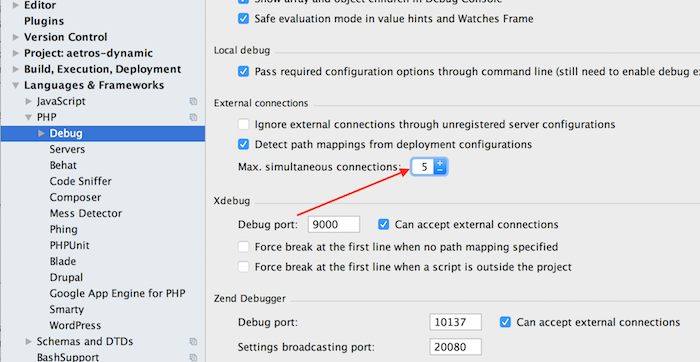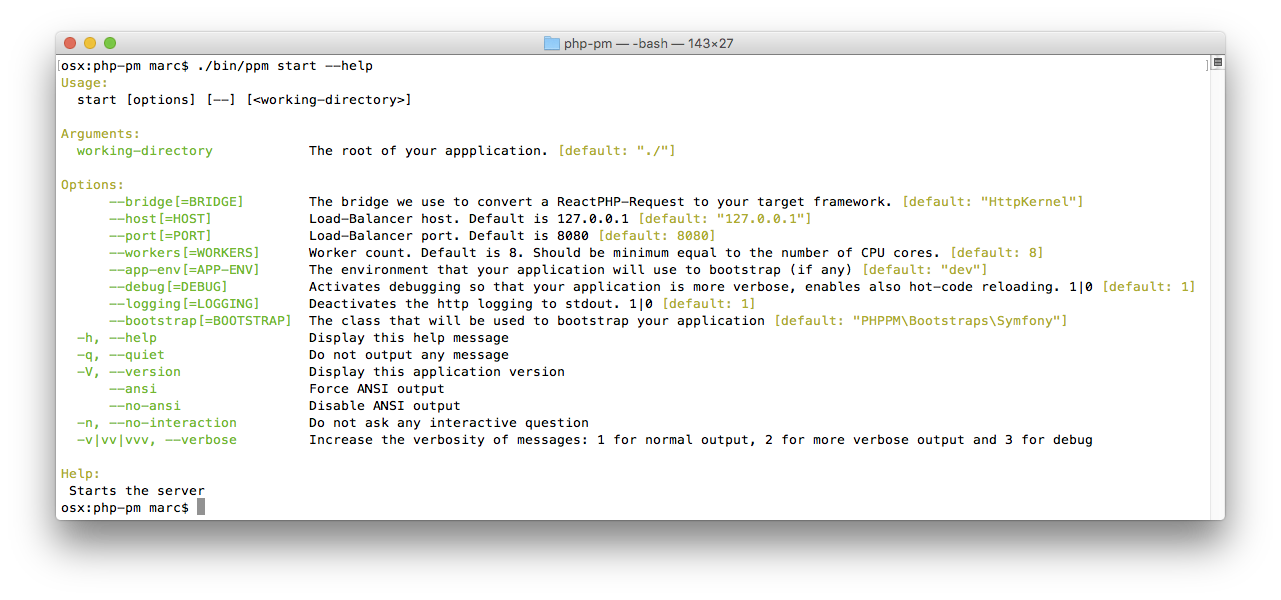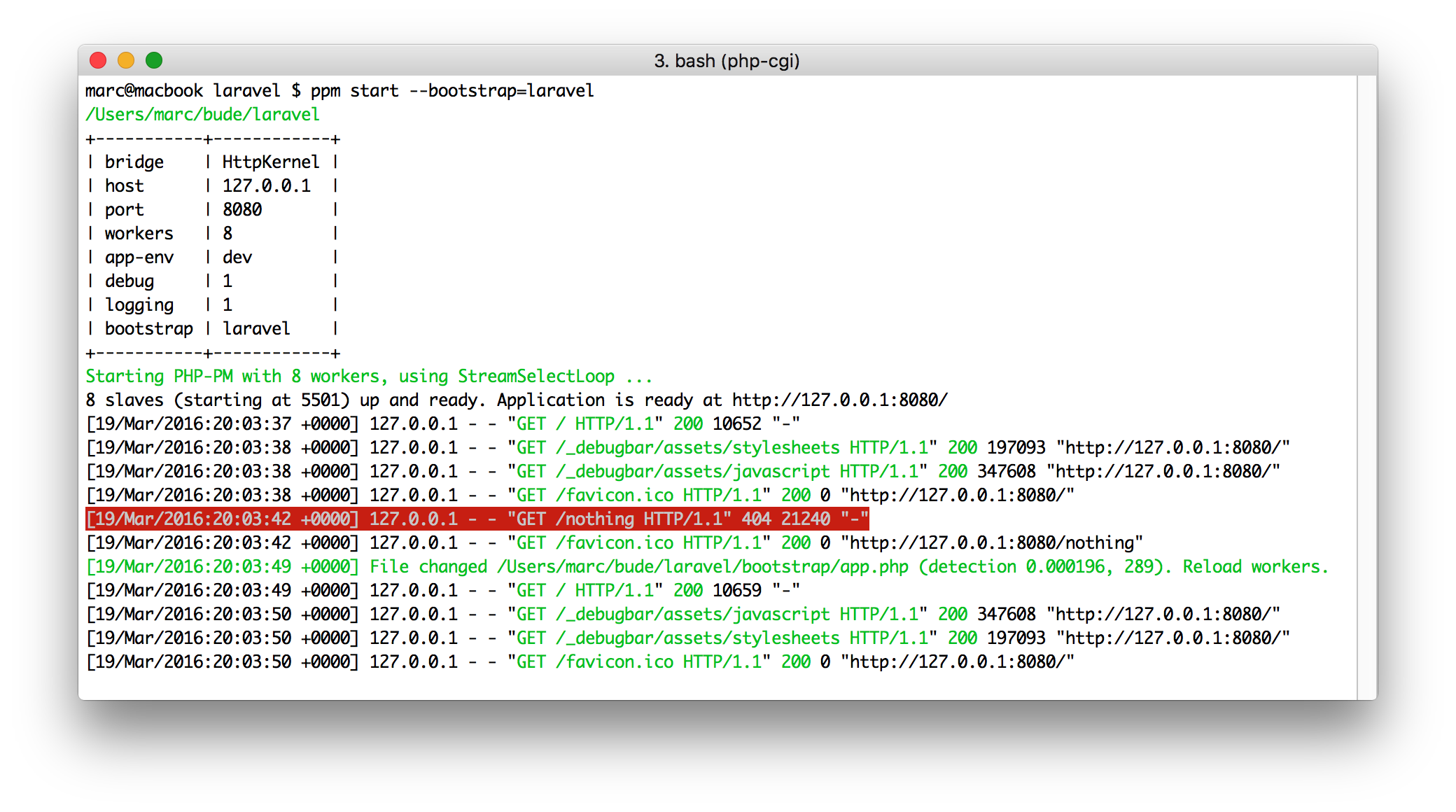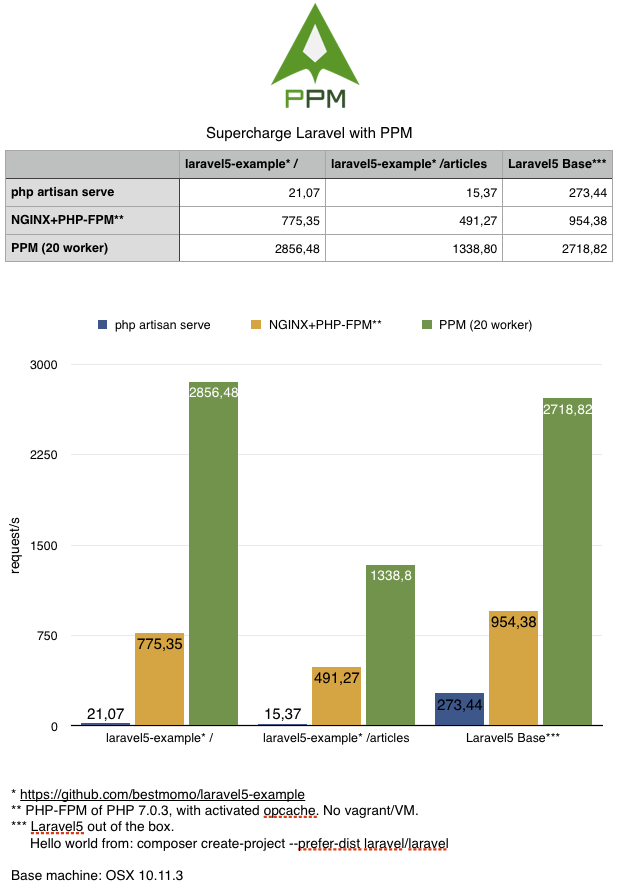 php-pm
php-pm
PPM is a process manager, supercharger and load balancer for modern PHP applications.
Top Related Projects
An advanced async HTTP server library for PHP, perfect for real-time apps and APIs with high concurrency demands.
���🤯 High-performance PHP application server, process manager written in Go and powered with plugins
🚀 Coroutine-based concurrency library for PHP
Quick Overview
PHP-PM (PPM) is a process manager, supercharger, and load balancer for PHP applications. It aims to boost performance by maintaining a pool of ready-to-use PHP workers, eliminating the need to bootstrap the application for each request. PPM is designed to work with various PHP frameworks and applications.
Pros
- Significantly improves PHP application performance by reducing bootstrap overhead
- Supports multiple popular PHP frameworks out of the box (Symfony, Laravel, Zend Framework)
- Provides built-in load balancing and process management
- Offers easy integration with existing PHP applications
Cons
- Requires additional setup and configuration compared to traditional PHP deployments
- May not be suitable for all types of PHP applications, especially those with specific runtime requirements
- Limited support for some PHP extensions and features that rely on per-request initialization
- Potential learning curve for developers unfamiliar with process management concepts
Code Examples
- Starting PPM with a Symfony application:
<?php
use PHPPM\Bridges\Symfony;
$bridge = new Symfony();
$bridge->bootstrap();
$app = $bridge->getApplication();
// Your Symfony application is now bootstrapped and ready to handle requests
- Configuring PPM for a Laravel application:
<?php
return [
'bridge' => PHPPM\Bridges\Laravel::class,
'host' => '127.0.0.1',
'port' => 8080,
'workers' => 8,
'app-env' => 'production',
'debug' => false,
'logging' => false,
'static-directory' => 'public/',
];
- Handling a request in a custom PPM bridge:
<?php
namespace PHPPM\Bridges;
use PHPPM\Bridges\HttpKernel;
class CustomBridge extends HttpKernel
{
public function handle(ServerRequestInterface $request): ResponseInterface
{
// Custom request handling logic
$response = $this->application->handle($request);
return $response;
}
}
Getting Started
-
Install PHP-PM using Composer:
composer require php-pm/php-pm -
Create a PPM configuration file (ppm.json):
{ "bridge": "PHPPM\\Bridges\\Symfony", "host": "127.0.0.1", "port": 8080, "workers": 8, "app-env": "prod", "debug": false } -
Start PPM:
./vendor/bin/ppm start --config=ppm.json
Your PHP application is now running with PHP-PM, ready to handle requests with improved performance.
Competitor Comparisons
An advanced async HTTP server library for PHP, perfect for real-time apps and APIs with high concurrency demands.
Pros of http-server
- Built on the amphp ecosystem, providing seamless integration with other amphp components
- Designed for high concurrency and non-blocking I/O, potentially offering better performance in certain scenarios
- More actively maintained with regular updates and contributions
Cons of http-server
- Steeper learning curve due to its asynchronous nature and unique programming model
- Less widespread adoption compared to php-pm, potentially resulting in a smaller community and fewer resources
Code Comparison
http-server:
$server = new Server($logger, $socket);
$server->expose($socket);
$server->start();
php-pm:
$loop = Factory::create();
$app = new Application($loop);
$app->run('0.0.0.0:8080');
Both projects aim to improve PHP's performance in serving HTTP requests, but they take different approaches. http-server focuses on leveraging asynchronous programming patterns, while php-pm emphasizes process management and worker pooling. The choice between them depends on specific project requirements, familiarity with asynchronous programming, and the desired level of integration with other components in the respective ecosystems.
🤯 High-performance PHP application server, process manager written in Go and powered with plugins
Pros of RoadRunner
- Written in Go, offering better performance and lower memory usage
- Supports multiple PHP versions and frameworks out of the box
- Includes built-in load balancing and service discovery features
Cons of RoadRunner
- More complex setup and configuration compared to PHP-PM
- Requires additional system dependencies (Go runtime)
- May have a steeper learning curve for PHP developers unfamiliar with Go
Code Comparison
RoadRunner configuration (.rr.yaml):
http:
address: 0.0.0.0:8080
workers:
command: "php worker.php"
pool:
numWorkers: 4
PHP-PM configuration:
$loop = \React\EventLoop\Factory::create();
$socket = new \React\Socket\Server('0.0.0.0:8080', $loop);
$server = new \PHPPM\ProcessManager\ProcessManager($loop, $socket);
$server->setProcessCount(4);
$server->run();
Both projects aim to improve PHP application performance by managing worker processes. RoadRunner offers a more feature-rich solution with better performance, while PHP-PM provides a simpler, pure PHP implementation. The choice between them depends on project requirements, team expertise, and infrastructure constraints.
🚀 Coroutine-based concurrency library for PHP
Pros of swoole-src
- Written in C, offering better performance and lower resource usage
- Provides a more comprehensive set of features, including WebSocket, TCP/UDP server, and async I/O operations
- Integrates seamlessly with PHP as an extension, allowing for easier adoption in existing projects
Cons of swoole-src
- Requires compilation and installation as a PHP extension, which can be more complex than php-pm
- May have compatibility issues with some PHP libraries and frameworks not designed for asynchronous execution
Code Comparison
swoole-src:
$server = new Swoole\HTTP\Server('127.0.0.1', 9501);
$server->on('request', function ($request, $response) {
$response->end('<h1>Hello World</h1>');
});
$server->start();
php-pm:
$app = new Symfony\Component\HttpFoundation\Request();
$app->get('/', function () {
return new Response('<h1>Hello World</h1>');
});
Summary
swoole-src offers superior performance and a wider range of features, making it suitable for high-performance applications. However, it requires more setup and may have compatibility issues. php-pm is easier to integrate but may not provide the same level of performance or feature set. The choice between the two depends on project requirements and the development team's expertise.
Convert  designs to code with AI
designs to code with AI

Introducing Visual Copilot: A new AI model to turn Figma designs to high quality code using your components.
Try Visual CopilotREADME
PPM - PHP Process Manager
PHP-PM is a process manager, supercharger and load balancer for PHP applications.
It's based on ReactPHP and works best with applications that use request-response frameworks like Symfony's HTTPKernel. The approach of this is to kill the expensive bootstrap of PHP (declaring symbols, loading/parsing files) and the bootstrap of feature-rich frameworks. See Performance section for a quick hint. PHP-PM basically spawns several PHP instances as worker bootstraping your application (eg. the whole Symfony Kernel) and hold it in the memory to be prepared for every incoming request: This is why PHP-PM makes your application so fast.
More information can be found in the article: Bring High Performance Into Your PHP App (with ReactPHP)
Features
- Performance boost up to 15x (compared to PHP-FPM, Symfony applications).
- Integrated load balancer.
- Hot-Code reload (when PHP files change).
- Static file serving for easy development procedures.
- Support for HttpKernel (Symfony/Laravel), Drupal (experimental), Zend (experimental).
Badge all the things
Does your app/library support PPM? Show it!
[](https://github.com/php-pm/php-pm)
Use
cd into/your-application
# run Symfony
docker run -v "$(pwd):/var/www" -p 8080:80 phppm/nginx --bootstrap=symfony --static-directory=web/
# run Laravel
docker run -v "$(pwd):/var/www" -p 8080:80 phppm/nginx --bootstrap=laravel --static-directory=public/
Docker is easier to setup and maintain. If your applications requires additional environment tools or libraries, you can build your own image based on ours. See github.com/php-pm/php-pm-docker for more information.
When debug is enabled, PHP-PM detects file changes and restarts its worker automatically.
Use without Docker
Follow the wiki article Use without Docker.
Performance
To get the maximum performance you should usually use --app-env=prod with disabled
debug --debug=0. Also make sure xdebug is disabled. Try with different amount of workers.
Usually a 10% over your cpu core count is good. Example: If you have 8 real cores (excl. hyper-threading) use --workers=9.
To get even more performance (for static file serving or for rather fast applications) try a different event loop (see https://github.com/reactphp/event-loop).
Debugging
If you get strange issues in your application and you have no idea where they are coming from try
using only one worker --workers=1 and enable -v or -vv.
When debugging you should use xdebug as you're used to. If you set a break point and hold the application, then only one worker is stopped until you release the break point. All other workers are fully functional.
Note for XDebug and PHPStorm: Since php-pm uses at least two processes, there are two xdebug instances as well. PHPStorm is per default configured to only accept one connection at a time. You need to increase that. You won't get xdebug working with your application if you don't increase that count.

In all workers the STDOUT is redirected to the connected client. So take care, var_dump, echo are not displayed on the console.
STDERR is not redirected to the client, but to the console. So, for very simple debugging you could use error_log('hi') and you'll see it on the console.
Per default exceptions and errors are only displayed on the console, prettified with Symfony/Debug component.
Adapter
HttpKernel for Symfony/Laravel - https://github.com/php-pm/php-pm-httpkernel
Zend - https://github.com/php-pm/php-pm-zend
CakePHP - https://github.com/CakeDC/cakephp-phppm
Command


Symfony
cd my-project
docker run -v `pwd`:/var/www -p 8080:80 phppm/nginx --static-directory=web/
Laravel
cd my-project
docker run -v `pwd`:/var/www -p 8080:80 phppm/nginx --bootstrap=laravel --static-directory=web/
Zend
cd my-project
docker run -v `pwd`:/var/www -p 8080:80 phppm/nginx --bootstrap=Zf2
Wordpress
For all Wordpress lovers out there: PPM is not going to work with Wordpress due to the lack of request-response abstraction. We highly doubt that Wordpress is ever going to be compatible because its architecture is written in a way that makes it currently impossible to serve multiple requests in one application process.
Performance (requests/s)
6x4GHz Intel i7, 16GB RAM. 10 concurrent, 1000 total request: ab -c 10 -n 1000 http://127.0.0.1:8080/
Symfony, CMS application
ppm start --bootstrap=symfony --app-env=prod --logging=0 --debug=0 --workers=20
https://github.com/jarves/jarves
| PHP Version | Dynamic at Jarves | Static file |
|---|---|---|
| 7.0.3, StreamSelectLoop | 2387,67 | 3944,52 |
| 5.6.18, StreamSelectLoop | 1663,56 | 2636,09 |
| 5.6.18, LibEventLoop | 1811,76 | 3441,72 |
Laravel, example package
https://github.com/bestmomo/laravel5-example
ppm start --bootstrap=laravel --app-env=prod --debug=0 --logging=0 --workers=20

Issues
- Memory leaks, memory leaks and memory leaks. You will also find leaks in your application. :) But no big issue since workers restart automatically.
- Does not work with ExtEventLoop. (So don't install
php70-event, but you can try LibEventLoopphp56-libevent) - Drupal and Zend is very experimental and not fully working. Try using https://github.com/php-pm/php-pm-drupal.
- Laravel's debugger isn't working perfectly yet since it's still needed to reset some stuff after each request.
- Streamed responses are not streamed yet
- No windows support due to signal handling
Please help us fix these issues by creating pull requests. :)
Setup
We provide ready-to-use docker images you can use right away. If you have own setup, see in the PHP-PM docker repository how to integrate PHP-PM in your NGiNX setup.
Trusted proxy Symfony
To get the real remote IP in your Symfony application for example, don't forget to add ppm (default 127.0.0.1)
as trusted reverse proxy.
# app/config/config.yml
# ...
framework:
trusted_proxies: [127.0.0.1]
More information at http://symfony.com/doc/current/cookbook/request/load_balancer_reverse_proxy.html.
Top Related Projects
An advanced async HTTP server library for PHP, perfect for real-time apps and APIs with high concurrency demands.
🤯 High-performance PHP application server, process manager written in Go and powered with plugins
🚀 Coroutine-based concurrency library for PHP
Convert  designs to code with AI
designs to code with AI

Introducing Visual Copilot: A new AI model to turn Figma designs to high quality code using your components.
Try Visual Copilot